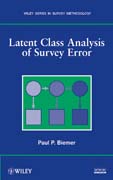
INDICE: Preface. Abbreviations. 1. Survey Error Evaluation. 1.1 Survey Error. 1.1.1 An Overview of Surveys. 1.1.2 Survey Quality and Accuracy and Total Survey Error. 1.1.3 Nonsampling Error. 1.2 Evaluating the Mean-Squared Error. 1.2.1 Purposes of MSE Evaluation. 1.2.2 Effects of Nonsampling Errors on Analysis. 1.2.3 Survey Error Evaluation Methods. 1.2.4 Latent Class Analysis. 1.3 About This Book. 2. A General Model for Measurement Error. 2.1 The Response Distribution. 2.1.1 A Simple Model of the Response Process. 2.1.2 The Reliability Ratio. 2.1.3 Effects of Response Variance on Statistical Inference. 2.2 Variance Estimation in the Presence of Measurement Error. 2.2.1 Binary Response Variables. 2.2.2 Special Case: Two Measurements. 2.2.3 Extension to Polytomous Response Variables. 2.3 Repeated Measurements. 2.3.1 Designs for Parallel Measurements. 2.3.2 Nonparallel Measurements. 2.3.3 Example: Reliability of MarijuanaUse Questions. 2.3.4 Designs Based on a Subsample. 2.4 Reliability of Multiitem Scales. 2.4.1 Scale Score Measures. 2.4.2 Cronbachs Alpha. 2.5 True Values,Bias, and Validity. 2.5.1 A True Value Model. 2.5.2 Obtaining True Values. 2.5.3 Example: Poor- or Failing-Grade Data. 3. Response Probability Models for Two Measurements. 3.1 Response Probability Model. 3.1.1 Bross Model. 3.1.2 Implications for Survey Quality Investigations. 3.2 Estimating À, ¸, and Æ. 3.2.1 Maximum-Likelihood Estimates of À, ¸, and Æ. 3.2.2 The EM Algorithm for Two Measurements. 3.3 HuiWalter Model for Two Dichotomous Measurements. 3.3.1 Notation and Assumptions. 3.3.2 Example: Labor Force Misclassifi cations. 3.3.3 Example: Mode of Data Collection Bias. 3.4 Further Aspects of the HuiWalter Model.3.4.1 Two Polytomous Measurements. 3.4.2 Example: Misclassifi cation with Three Categories. 3.4.3 Sensitivity of the HuiWalter Method to Violations in the Underlying Assumptions. 3.4.4 HuiWalter Estimates of Reliability. 3.5 Three orMore Polytomous Measurements. 4. Latent Class Models for Evaluating Classifi cation Errors. 4.1 The Standard Latent Class Model. 4.1.1 Latent Variable Models. 4.1.2 An Example from Typology Analysis. 4.1.3 Latent Class Analysis Software. 4.2 Latent Class Modeling Basics. 4.2.1 Model Assumptions. 4.2.2 Probability Model Parameterization of the Standard LC Model. 4.2.3 Estimation of the LC Model Parameters. 4.2.4 Loglinear Model Parameterization. 4.2.5 Example: Computing Probabilities Using Loglinear Parameters. 4.2.6 Modifi ed Path Model Parameterization. 4.2.7 Recruitment Probabilities. 4.2.8 Example: Computing Probabilities Using Modified Path Model Parameters. 4.3 Incorporating Grouping Variables. 4.3.1 Example: Loglinear Parameterization of the HuiWalter Model. 4.3.2 Example: Analysis of Past-Year Marijuana Use with Grouping Variables. 4.4 Model Estimation and Evaluation. 4.4.1 EM Algorithm for the LL Par
- ISBN: 978-0-470-28907-5
- Editorial: John Wiley & Sons
- Encuadernacion: Cartoné
- Páginas: 416
- Fecha Publicación: 17/12/2010
- Nº Volúmenes: 1
- Idioma: Inglés
